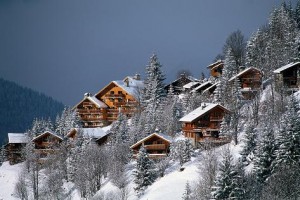 I remember a guy once explained to me some years back that “Ski resorts are just like golf course communities. The golf course itself is a money loser and is only there as an amenity to attract real estate development”. Over years of casual conversation with other armchair experts, I have been led to believe a few of these supposed axioms regarding resort economics. One of the most enduring may be –
I remember a guy once explained to me some years back that “Ski resorts are just like golf course communities. The golf course itself is a money loser and is only there as an amenity to attract real estate development”. Over years of casual conversation with other armchair experts, I have been led to believe a few of these supposed axioms regarding resort economics. One of the most enduring may be –
“The true economic driver of any big resort is not ticket sales, but lodging and real estate”
As an example of popular sentiment, here is an anonymous post from an online forum – “The only reason we get to go skiing at all is because the actual ski area is on Forest Service land, and the use permit requires them to allow the general public to buy lift tickets. Otherwise, most resorts would absolutely love to kick everyone off the hill except for landowners, people renting hotel rooms or places to stay, and their guests.”
Investors.com reports that Vail Resort’s operations are grouped into three business segments: Mountain, Lodging, and Real Estate. The Mountain segment includes ticket sales, ski school, rentals, retail, and dining. The Lodging segment owns and/or manages hotels and condominiums. The Real Estate segment owns and develops real estate in and around the resort communities.
While the “golf course” analogy above may be a bit extreme, it describes the failed Yellowstone Club venture in Montana to a tee. And closer to home is the recent bankruptcy filed by the town of Mammoth Lakes and the June Mountain closure debacle, both of which could be blamed all, or in part on real estate woes.
 Going forward, it’s obvious that the mega-resorts have had to basically write off the real estate segment since the market crashed about five or so years ago. In fact Vail Resort’s last annual statement showed real estate bringing in a paltry $13.8M in revenue compared to a total of $456M for the other two segments. So making ends meet with only two of the three segments has been the mandate for a while now and maybe into the foreseeable future.
Going forward, it’s obvious that the mega-resorts have had to basically write off the real estate segment since the market crashed about five or so years ago. In fact Vail Resort’s last annual statement showed real estate bringing in a paltry $13.8M in revenue compared to a total of $456M for the other two segments. So making ends meet with only two of the three segments has been the mandate for a while now and maybe into the foreseeable future.
But what about operating with just the “mountain segment” only? Many seem to do so and thrive, or at least maintain a going concern. Among many others, Alta, A-basin, and Wolf Creek would be examples. But Mt. Bachelor in particular represents an extreme case succeeding in the face of adversity.
To be precise, it may be a misnomer to even call Bachelor and others like it “resorts”. It has no real estate on the mountain, no lodging at the resort, and no real base village with only one cafeteria and ski shop. But to handicap it even further, it also has –
- no significant population base anywhere near
- transportation requires a long drive or air service on small regional carriers
- Infamously sketchy weather
Yet despite all this, and a reasonable daily lift ticket price, Bachelor seems to be a “myth buster”. What it does have is world class terrain with continued expansion announcements, the lifts are mostly newer high speed quads with automatic ticket scanners, and their web and social media sites are always announcing new on/off mountain improvements and events. It is a skier’s mountain with a no nonsense attitude and a passionate rider community.
It’s always possible things are not what they appear to be, but from a customer’s point of view, it seems that Mt. Bachelor has somehow figured out how to run a dynamic and successful ski resort business without two of the three sacred pillars. But this article isn’t meant to toot Bachelor’s horn as much as it is to find out what is it that Bachelor may be doing different and what business model really works in today’s market.
As an example, a smaller resort with almost the identical market disadvantages as Bachelor, is Monarch Mountain in southern Colo. A recent article from the Denver Post points out some interesting facts (paraphrased).
Since the current owners bought the 800-acre hill in 2002 from Chinese investors, Monarch has thrived. Visitation has climbed 32 percent — from nearly 140,000 in 2002 to a record 185,000 skier visits last year (statistics show a steady upward trend) — and revenue has doubled, delivering handsome and unexpected dividends during an economic downturn that has pinched most other resorts.
With a slow-and-steady, debt-free strategy intact, keeping it about family skiing is a mantra at Monarch. While corporately owned hills focused on developing high-end real estate that fueled the resort industry’s spectacular growth through the early 2000s, Monarch plowed money — almost $6 million in the last nine years — into the skiing.
And customers claim it’s some small things that help make a difference – affordable food, coolers allowed, and free parking for instance. All while keeping lift ticket prices below $60.
But don’t get lulled into ringing the death knell for the real estate business model. The Jumbo Glacier Resort in British Columbia was first proposed in 1991, and this giant real estate and resort development proposal now enters its 23rd year of controversy. Despite overwhelming popular opposition, politicians have continued to pave the way for this development including even appointing a new mayor for a town with no residents!

Artist rendition of the proposed resort
The completed development would be massive, constructed on Crown land, and would consist of a village of condos, chalets, shops and hotels with thousands of guests and residents. It would provide 20 lifts for expensive year-around skiing on several nearby glaciers.
This despite the fact that all BC resorts have been experiencing a steady drop in skier visits since 2008 and nearby Panorama resort has been operating in the red. Does it really make sense to add another player to an already saturated market? I guess it might depend upon who you are. Some stand to make a huge financial gain in the short term with little or no concern for future viability. Those who create bubbles have a knack for being long gone by the time they burst.
So what’s the bottom line? Have some resorts put too much emphasis on lodging and real estate in particular? Have they maybe been dazzled by the lure of big money in good times while losing focus of their core business? Has this set them up for a struggle in the leaner times we’re experiencing now? What direction do you think current resort management thinking is headed? Has all this affected any real change in resort management philosophy?
It’s doubtful at this point if the Jumbo Glacier development will ever come to pass. The public sentiment for these giant projects seems to have run its course. So while the Bachelor / Monarch business model may not be nearly as financially glamorous, it may be much more sustainable in the long run.
What do you think really works???









Great article and conversation starter. To begin with, I think you are correct in differentiating between a ski area and a ski resort.
I do believe that many smaller, community type ski areas could thrive under a new ownership model. Instead of one person or corporation expecting a 10% or more return on their investment, I believe community ownership, in the form of a Co-op or Membership, could prove viable. People would not invest smaller amounts of money in their ski area for a profit, but rather to preserve or improve their Mountain Playground. If there are profits, they are reinvesting in needed infrastructure improvements and put aside for a poor season.
When I meet with Mad River Glen last season, they told me that first they take money from Co-op members, then they volunteer for life. We have seen the pooling of community resources in many other industries, such as food co-ops as well as the emergence of crowdfunding. There is no reason why this model couldn’t work for many ski areas in North America.
Thanks Jamie. You may want to join the rather lively discussion on http://www.epicski.com/t/121450/ski-resort-economics-what-really-works/30#post_1612173
Bachelor sells appx 10,000 season passes to the local community and they use them well above the national average. Sort of relevant if you’re talking business models.
Mediawithak,
Is that high or low in comparison with other resorts of like size? If it’s high, what would you attribute this to? I know they are not cheap in comparison with some of the deals now available in CO and CA.
This article actually gets mentioned by Powder Magazine!!! Check out third story down “Food for Thought”
http://www.powdermag.com/stories/week-in-review-september-6-lego-chairlifts-and-tempting-fear/
Vail Resorts is buying local ski areas (Afton Alps in Minnesota and Mt. Brighton in Michigan). Are these purchases coming off the “lodging” marketing P&L to drive traffic to the larger resorts they own?